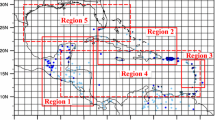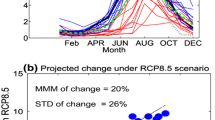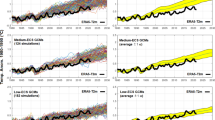Abstract
The climatological mean state, seasonal variation and long-term upward trend of 1979–2005 latent heat flux (LHF) in historical runs of 14 coupled general circulation models from CMIP5 (Coupled Model Intercomparison Project Phase 5) are evaluated against OAFlux (Objectively Analyzed air–sea Fluxes) data. Inter-model diversity of these models in simulating the annual mean climatological LHF is discussed. Results show that the models can capture the climatological LHF fairly well, but the amplitudes are generally overestimated. Model-simulated seasonal variations of LHF match well with observations with overestimated amplitudes. The possible origins of these biases are wind speed biases in the CMIP5 models. Inter-model diversity analysis shows that the overall stronger or weaker LHF over the tropical and subtropical Pacific region, and the meridional variability of LHF, are the two most notable diversities of the CMIP5 models. Regression analysis indicates that the inter-model diversity may come from the diversity of simulated SST and near-surface atmospheric specific humidity. Comparing the observed long-term upward trend, the trends of LHF and wind speed are largely underestimated, while trends of SST and air specific humidity are grossly overestimated, which may be the origins of the model biases in reproducing the trend of LHF.
Similar content being viewed by others
References
Alexander, M. A., and J. D. Scott, 1997: Surface flux variability over the North Pacific and North Atlantic Oceans. J. Climate, 10, 2963–2978.
Berry, D. I., and E. C. Kent, 2009: A new air-sea interaction gridded dataset from ICOADS with uncertainty estimates. Bull. Amer. Meteor. Soc., 90, 645–656.
Berry, D. I., and E. C. Kent, 2011: Air-sea fluxes from ICOADS: The construction of a new gridded dataset with uncertainty estimates. Inter. J Climatol., 31, 987–1001.
Bigg, G. R., T. D. Jickells, P. S. Liss, and T. J. Osborn, 2003: The role of the oceans in climate. Int. J. Climatol., 23, 1127–1159, doi: 10.1002/joc.926.
Burgman, R. J., A. C. Clement, C. M. Mitas, J. Chen, and K. Esslinger, 2008: Evidence for atmospheric variability over the Pacific on decadal timescales. Geophys. Res. Lett., 35(1), L01704, doi: 10.1029/2007GL031830.
Cayan, D. R., 1992a: Variability of latent and sensible heat fluxes estimated using bulk formulae. Atmos.-Ocean, 30, 1–42.
Cayan, D. R., 1992b: Latent and sensible heat flux anomalies over the northern oceans: The connection to monthly atmospheric circulation. J. Climate, 5, 354–369.
Cayan, D. R., 1992c: Latent and sensible heat flux anomalies over the northern oceans: Driving the sea surface temperature. J. Phys. Oceanogr., 22, 859–881.
Chen, J. Y., B. E. Carlson, and A. D. Del Genio, 2002: Evidence for strengthening of the tropical general circulation in the 1990s. Science, 295, 838–841.
Fairall, C. W., E. F. Bradley, J. E. Hare, A. A. Grachev, and J. B. Edson, 2003: Bulk parameterization of air-sea fluxes: updates and verification for the COARE algorithm. J. Climate, 16, 571–591.
Grodsky, S. A., A. Bentamy, J. A. Carton, and R. T. Pinker, 2009: Intraseasonal latent heat flux based on satellite observations. J. Climate, 22, 4539–4556.
Gulev, S. K., 1995: Long-term variability of sea-air heat transfer in the North Atlantic Ocean. Inter. J. Climatol., 15, 825–852, doi: 10.1002/joc.3370150802.
Hayashi, Y., 1982: Confidence intervals of a climatic signal. J. Atmos. Sci., 39, 1895–1905.
Held, I. M., and B. J. Soden, 2006: Robust responses of the hydrological cycle to global warming. J. Climate, 19(21), 5686–5699.
Kiehl, J. T., and K. E. Trenberth, 1997: Earth’s annual global mean energy budget. Bull. Amer. Meteor. Soc., 78, 197–208.
Li, G., B. H. Ren, C. Y. Yang, and J. Q. Zheng, 2011a: Revisiting the trend of the tropical and subtropical Pacific surface latent heat flux during 1977–2006. J. Geophys. Res., 116, D10115, doi: 10.1029/2010JD015444.
Li, G., B. H. Ren, J. Q. Zheng, and C. Y. Yang, 2011b: Net air-sea surface heat flux during 1984–2004 over the North Pacific and North Atlantic oceans (10°N–50°N): Annual mean climatology and trend. Theor. Appl. Climatol., 104, 387–401.
Li, G., and S. P. Xie, 2012: Origins of tropical-wide SST biases in CMIP multi-model ensembles. Geophys. Res. Lett., 39(22), L22703, doi: 10.1029/2012GL053777.
Liu, J. P., and J. A. Curry, 2006: Variability of the tropical and subtropical ocean surface latent heat flux during 1989–2000. Geophys. Res. Lett., 33, L05706, doi: 10.1029/2005GL024809.
Liu, W. T., K. B. Katsaros, and J. A. Businger, 1979: Bulk parameterizations of air-sea exchanges of heat and water vapor including the molecular constraints at the interface. J. Atmos. Sci., 36, 1722–1735.
Maurer, E. P., and H. G. Hidalgo, 2008: Utility of daily vs. monthly large-scale climate data: an intercomparison of two statistical downscaling methods. Hydrology and Earth System Sciences, 12, 551–563.
Maurer, E. P., L. D. Brekke, and T. Pruitt, 2010: Contrasting lumped and distributed hydrology models for estimating climate change impacts on California watersheds. Journal of the American Water Resources Association, 46(5), 1024–1035.
Meehl, G. A., G. J. Boer, C. Covey, M. Latif, and R. J. Stouffer, 1997: Intercomparison makes for a better climate model. Eos, Trans. Amer. Geophys. Union, 78(41), 445–451.
Meehl, G. A., G. J. Boer, C. Covey, M. Latif, and R. J. Stouffer, 2000: The coupled model intercomparison project (CMIP). Bull. Amer. Meteor. Soc., 81(2), 313–318.
Mitas, C. M., and A. Clement, 2006: Recent behavior of the Hadley cell and tropical thermodynamics in climate models and reanalyses. Geophys. Res. Lett., 33(1), L01810, doi: 10.1029/2005GL024406.
O’Brien, E. W., and F. Horsfall, 1995: Sensitivity of the heat budget in a midlatitude ocean model to variations in atmospheric forcing. J. Geophys. Res., 100, 24761–24772.
Papadopoulos, V. P., Y. Abualnaja, S. A. Josey, A. Bower, D. E. Raitsos, H. Kontoyiannis, and I. Hoteit, 2013: Atmospheric forcing of the winter air-sea heat fluxes over the Northern Red Sea. J. Climate, 26, 1685–1701.
Quan, X. W., H. F. Diaz, and M. P. Hoerling, 2004: Change in the tropical Hadley cell since 1950. The Hadley Circulation: Present, Past, and Future, Diaz and Bradley, Eds., Springer Netherlands, 85–120.
Reichler, T., and J. Kim, 2008: How well do coupled models simulate today’s climate. Bull. Amer. Meteor. Soc., 89(3), 303–311.
Santer, B. D., T. M. L. Wigley, J. S. Boyle, D. J. Gaffen, J. J. Hnilo, D. Nychka, D. E. Parker, and K. E. Taylor, 2000: Statistical significance of trends and trend differences in layeraverage atmospheric temperature time series. J. Geophys. Res., 105(D6), 7337–7356.
Taylor, K. E., 2001: Summarizing multiple aspects of model performance in a single diagram. J. Geophys. Res., 106(D7), 7183–7192.
Trenberth, K. E., 1995: Atmospheric circulation climate changes. Climatic Change, 31, 427–453.
Trenberth, K. E., and A. Solomon, 1994: The global heat balance: Heat transports in the atmosphere and ocean. Climate Dyn., 10, 107–134.
Trenberth, K. E., J. T. Fasullo, and J. Kiehl, 2009: Earth’s global energy budget. Bull. Amer. Meteor. Soc., 90, 311–323.
Vecchi, G. A., and B. J. Soden, 2007: Global warming and the weakening of the tropical circulation. J. Climate, 20(17), 4316–4340.
Vecchi, G. A., B. J. Soden, A. T. Wittenberg, I. M. Held, A. Leetmaa, and M. J. Harrison, 2006: Weakening of tropical Pacific atmospheric circulation due to anthropogenic forcing. Nature, 441(7089), 73–76.
Wentz, F. J., L. Ricciardulli, K. Hilburn, and C. Mears, 2007: How much more rain will global warming bring? Science, 317(5835), 233–235.
Yu, L. S., 2007: Global variations in oceanic evaporation (1958–2005): The role of the changing wind speed. J. Climate, 20(21), 5376–5390.
Yu, L. S., and R. A. Weller, 2007: Objectively analyzed air-sea heat fluxes for the global ice-free oceans (1981–2005). Bull. Amer. Meteor. Soc., 88, 527–539.
Yu, L. S., R. A.Weller, and B. M. Sun, 2004: Mean and variability of the WHOI daily latent and sensible heat fluxes at in situ flux measurement sites in the Atlantic Ocean. J. Climate, 17, 2096–2118.
Yu, L. S., X. Z. Jin, and R. A. Weller, 2007: Annual, seasonal, and interannual variability of air-sea heat fluxes in the Indian Ocean. J. Climate, 20, 3190–3209.
Yu, L. S., X. Z. Jin, and R. A. Weller, 2008: Multidecade global flux datasets from the objectively analyzed air-sea fluxes (OAFlux) project: Latent and sensible heat fluxes, ocean evaporation, and related surface meteorological variables. Woods Hole Oceanographic Institution, OAFlux Project Technical Report OA-2008-01, 64 pp.
Yulaeva, E., N. Schneider, D. W. Pierce, and T. P. Barnett, 2010: Modeling of North Pacific climate variability forced by oceanic heat flux anomalies. J. Climate, 14, 4027–4046.
Zhou, L. T., 2013: Influence of thermal state of warm pool in western Pacific on sensible heat flux. Atmospheric Science Letters, 14, 91–96. doi: 10.1002/asl2.422
Zhou, L. T., G. S. Chen, and R. G. Wu, 2015: Change in surface latent heat flux and its association with tropical cyclone genesis in the western North Pacific. Theor. Appl. Climatol., 119, 221–227.
Zhou, Y. P., K. M. Xu, Y. C. Sud, and A. K. Betts, 2011: Recent trends of the tropical hydrological cycle inferred from Global Precipitation Climatology Project and International Satellite Cloud Climatology Project data. J. Geophys. Res., 116(D9), D09101, doi: 10.1029/2010JD015197.
Author information
Authors and Affiliations
Corresponding author
Rights and permissions
About this article
Cite this article
Cao, N., Ren, B. & Zheng, J. Evaluation of CMIP5 climate models in simulating 1979–2005 oceanic latent heat flux over the Pacific. Adv. Atmos. Sci. 32, 1603–1616 (2015). https://doi.org/10.1007/s00376-015-5016-8
Received:
Revised:
Accepted:
Published:
Issue Date:
DOI: https://doi.org/10.1007/s00376-015-5016-8




